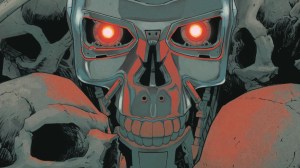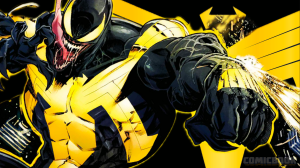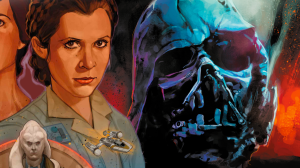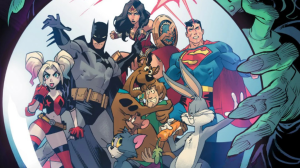
I’ve come to expect a great deal from Robinson’s writing in recent months and he continues to deliver in this comic. The real revelation here though is Tom Grummett. I know that he isn’t a stranger to the comics industry and in fact is a veteran with considerable experience over a number of years. Personally though, I’ve never seen much of the man’s work, at least in a context where I realized that it was his. That being said, the art in this comic blew me away. I’ll get more into it shortly but the pages feel full, characters are wonderfully expressive, and anatomy as well as architecture are depicted with a high degree of skill and in considerable detail.
I said above that this is what an annual should be and I meant it. In my mind, an annual should be somewhat self-contained, and feel special or meaningful in some way relative to a standard issue. This comic does both. While advancing the main Fantastic Four narrative, this comic focuses on a very specific event with its own rising action, climax, and resolution. Though plot threads still dangle and problems remain at its close, the reader feels as though he or she has read a reasonably complete story in this single issue. The comic also distinguishes itself as something special through the aforementioned excellent art as well as the scale of the fight depicted and important revelation at its end.
Videos by ComicBook.com
Before I get into some more details and spoilers, let me just sum up a bit by saying that this is an immensely enjoyable read that should be a real treat for fans of the Fantastic Four. Pick up a copy and see for yourself!
Now on to the breakdown, mind the SPOILERS!!!
The Good:
Tom Gummett blew me away with the art in this issue. I am legitimately impressed with how much I enjoyed the look and feel of this comic. Credit should of course be shared with inker Tom Palmer and colorist Jim Charalampidis, and across the board this comic is a fairly stunning visual package. Characters are depicted as being very expressive and in particular Susan “The Invisible Woman” Richards goes through a range of strong emotions all of which come across beautifully. Additionally, the architecture of the Latverian city of (I presume) Doomstadt is rendered superbly. All of the castles and Tudor-esque buildings are given a lovely and appropriately fairy tale appearance with excellent detail and geometric precision throughout. Another point in Tom’s favor is that for once Valeria actually looks like a child of the appropriate age. I’m not sure why this is such a problem for some artists but it seems as though a number of them have difficulty drawing a three or four year old without making her look a bit older or as though she is just a miniature teen or young adult.
One specific moment that I feel worth calling out is when Susan rips apart Doom’s throne room. The detail here with a section of wall being shoved away, timbers flying, and bricks raining down is truly impressive. Moments like this are why full-page spreads and splash pages exist. Another fantastic scene is when she slams Doom into a castle wall, sending bricks flying in all directions. Making this a horizontally-elongated panel extending across both pages helps to create an appropriate sense of motion.
Turning to the writing, Robinson continues to impress me. Reading the review to this point, you should have gathered that the main content of this issue is a fight between the Invisible Woman and Doctor Doom. The reason for the fight is that Susan’s daughter Valeria has been staying with Doom and Susan now wants to take her home, by force if necessary. What follows is the aforementioned altercation which ends with Doom defeated at Susan’s feet. Unfortunately, Valeria still wants to stay with Doom and has been frightened by her mother’s aggression. As a result, Susan leaves in tears without her daughter.
I’m quite pleased at Robinson’s treatment of Doom. Starting with the Hickman run on this series, Doom has been transitioning to something of an amoral force rather than an overtly villainous one. In particular, his interactions with his goddaughter Valeria have shown a level of humanity rarely seen in the character previously. I’m thrilled that Robinson continues to develop Doom along these lines while retaining his grandeur and sense of self-importance. Personally, I’m of the opinion that “Doom as villain” has been done to death and the longer we can keep up this trend of treating him as a more complex character the better. Along these lines, Doom’s line of, “Stand down! All of you! Do you think I want Valeria to see her mother’s slaughter?!” is brilliantly crafted suggesting that his affection for Valeria is the only think that is preventing him from calling for the outright killing of Susan Richards.
I would also like to compliment Robinson on his presentation of this story. It helps to sell this comic as an Annual and make it feel like a standalone read that the issue is bookended by narration captions framing it as a “Fairy Tale” (the issue’s title) with Doom as the “gallant Knight,” Valeria as the “beautiful Princess,” and Susan as the “wicked, wicked witch.” This also serves as a delightful inversion of Doom and Susan’s traditional hero/villain roles. It is also worth mentioning that depicting Doomstadt in its traditional Tudor-esque fashion helps to sell the comic is a play on fairy tales. Of course, positioning Susan Richards as a villain is helped by Robinson’s ballsiest move to date…


Now, I’m on record as hating Malice and I said so in my review of this series’ issue five and my look at issue five’s callbacks and references. I hate that god-awful dominatrix outfit she wears because apparently when female superheroes turn evil it is legally mandated that they need to show more skin, I think she’s been mishandled in the past, and however much sense Reed Richards slapping Susan made in the context of the original story I cannot warm up to domestic abuse (real, simulated, or however well-intentioned) as the resolution to a problem. That being said, Robinson seems to be treating the Malice concept very well here and somehow I found myself excited rather than repulsed when Doom discovered that her persona was residing in Sue’s mind when he attempted to invade it himself. In fact, his writing of Sue was coming across to me as subtly off which made perfect sense after the Malice reveal and made me completely reevaluate my assessment of this issue up to that point. I must say that was a surprising and gratifying experience as well as one which does not occur all that often.
For the moment and perhaps as a result of Robinson’s past performance on this series, I am legitimately excited to see where this goes. It seems as though Robinson is trying to cobble together a stellar run out of bringing back secondary cast members and integrating potentially poisonous plot elements. The crazy thing is that at least in my humble opinion it’s working brilliantly! So far, Robinson has managed to get the FF evicted from the Baxter Building and have Ben blow up about a failed attempt to turn him human without anything feeling old, tired, or frustrating in the slightest. For now, I say that Robinson has earned my trust enough that I’m even willing to accept that a good story can be made out of Malice. In fact, Robinson and whoever artist happens to take on the task will earn my undying gratitude if they invent a new costume for the character/persona that doesn’t make me want to gouge my eyes out and/or vomit in disgust.
Oh, and Mark Paniccia continues to toss in the occasional Editor’s Note which always brightens my assessment of a comic ever so slightly. It’s just nice to see that we’re paying attention to past continuity and thinking to reference specific issues now and again.
The Bad:
I have very little to say here. On the art front, there is one rendering of a globe with green lines emanating from Latveria showing Doom’s positive influence spreading out from it which is not badly drawn but is colored in such a way that at first I had no idea what I was looking at. Honestly, I may still not be correctly interpreting what that shape is but it’s the best I can make of it currently. Also, one minor nitpick would be that one of Susan Richards’ eyes appears to be oddly bulging in the panel where she says, “…I’m done hiding. Especially from you.”
On the writing front, I do have one bone to pick with Robinson. When Susan first arrives in Latveria, she finds that she has been talking to a robot version of her daughter at first rather than the actual Valeria. I understand that this was done to add to Susan’s frustration and give her another reason to be angry at Valeria but it makes little sense when we saw the robot talking and interacting with Doom previously. Val is angry at her parents and I can kind of understand why she would want to keep her distance and use an automaton rather than see her mother directly. The problem is that Doom was walking and talking with the robot before Susan arrived in a manner that suggested the robot was Valeria. What reason would Val have for not speaking with Doom in person? Why would Doom deign to address a robot rather than his actual goddaughter? Was this just a cheat to make the reader more surprised at the robot’s reveal? Regardless, it felt clumsy and a little contrived.
The Questionable:
Where we talk about things that are neither good nor necessarily bad, but are at least a little head-scratching.
I don’t know if this can be attributed to Malice but it feels wrong for Sue to address Val as “Baby” somehow, particularly as she may be young but has been said to be smarter than Reed. Wouldn’t Val resent the term as patronizing or derogatory in some other way and reject it?
Conclusion:
It’s like I’ve been saying, this is an excellent entry in an excellent run on this series. If you aren’t reading Robinson’s Fantastic Four you need to start now.





